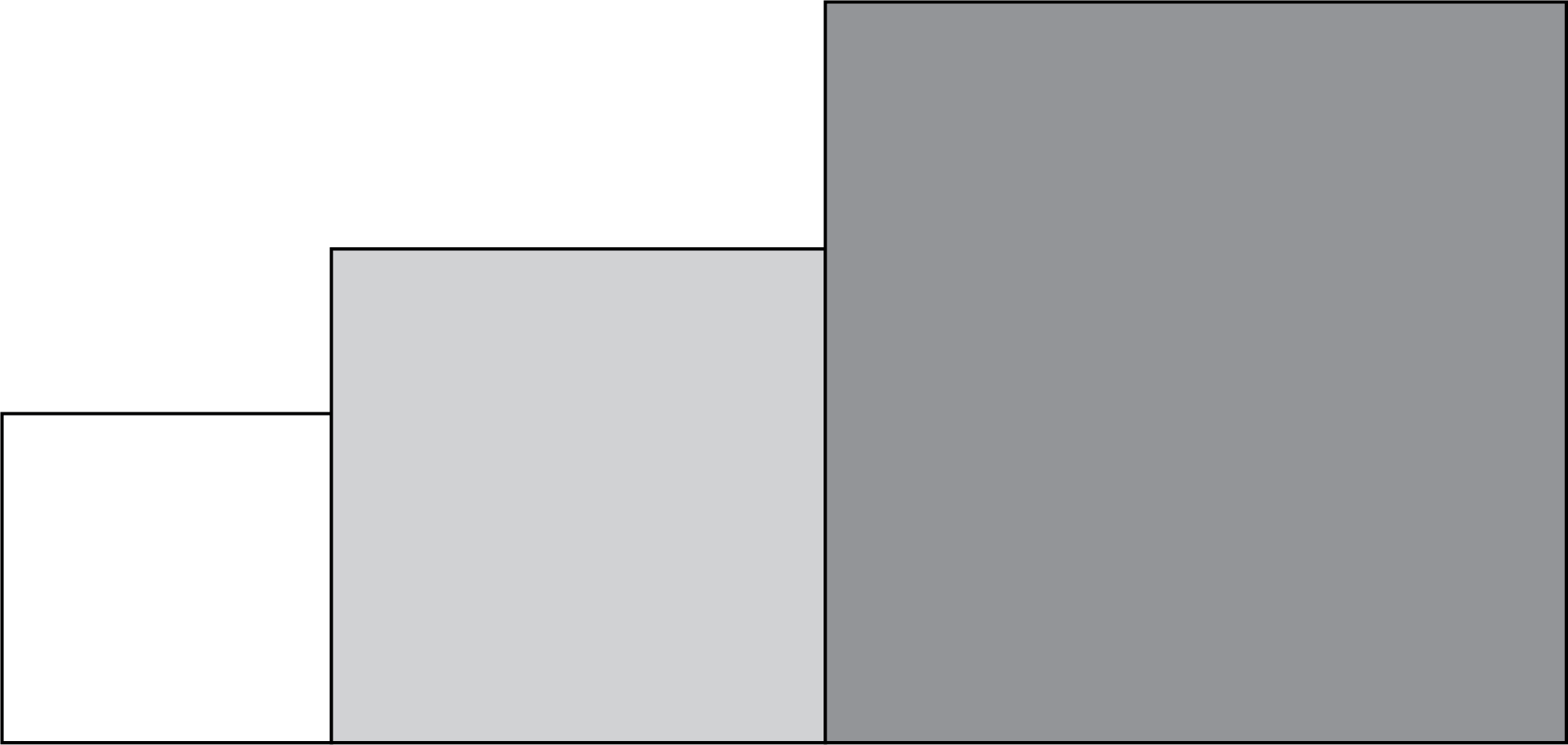

Three squares are placed side by side with the smallest square on the left and the largest square on the right. The bottom sides of the three squares form a horizontal line.

The side length of the smallest square is \(5\) units, and the side length of the medium-sized square is \(8\) units. If the top-left corner of each square all lie on a straight line, determine the side length of the largest square.
First we draw a line segment connecting the top-left corner of each square and label the vertices as shown in the diagram.

Let \(a\) represent the side length of the largest square. From here we present three different solutions.
In Solution 1, we solve the problem by calculating the slope of \(BH\). In Solution 2, we solve the problem using similar triangles. In Solution 3, we place the diagram on the \(xy\)-plane and solve the problem using analytic geometry.
Solution 1
The slope of a line is equal to its rise divided by its run. If we look at the line segment from \(B\) to \(E\), \(BC = 5\) and \(CE = DE - DC = 8-5 = 3\). Therefore, slope \(BE= \frac{CE}{BC} = \frac{3}{5}\).
If we look at the line segment from \(E\) to \(H\), \(EF = 8\) and \(FH = GH - GF = a - 8\). Therefore, slope \(EH= \frac{FH}{EF} = \frac{a-8}{8}\).
Since \(B\), \(E\), and \(H\) lie on a straight line, the slope of \(BE\) must equal the slope of \(EH\). Therefore, \[\begin{aligned} \frac{3}{5} &= \frac{a-8}{8}\\ 5(a-8) &= 3(8)\\ 5a-40 &= 24\\ 5a &= 64\\ a &= \frac{64}{5} \end{aligned}\] Therefore, the side length of the largest square is \(\dfrac{64}{5}\) units.
Solution 2
Consider \(\triangle BCE\) and \(\triangle EFH\). We will first show that \(\triangle BCE \sim \triangle EFH\).

Since \(ABCD\) is a square, \(\angle BCD = 90^{\circ}\). Therefore, \(\angle BCE = 180^{\circ} - \angle BCD = 180^{\circ} - 90^{\circ} = 90^{\circ}\). Since \(DEFG\) is a square, \(\angle EFG = 90^{\circ}\). Therefore, \(\angle EFH = 180^{\circ} - \angle EFG = 180^{\circ} - 90^{\circ} = 90^{\circ}\). Thus, \(\angle BCE = \angle EFH\).
Since \(ABCD\) and \(DEFG\) are squares and \(AG\) is a straight line, \(BC\) is parallel to \(EF\). Therefore, \(\angle EBC\) and \(\angle HEF\) are corresponding angles and so \(\angle EBC = \angle HEF\).
Since the angles in a triangle add to \(180^{\circ}\), then we must also have \(\angle BEC = \angle EHF\).
Therefore, \(\triangle BCE \sim \triangle EFH\), by Angle-Angle-Angle Triangle Similarity.
Since \(\triangle BCE \sim \triangle EFH\), corresponding side lengths are in the same ratio. In particular, \[\begin{aligned} \frac{EC}{BC} &= \frac{HF}{EF}\\ \frac{DE - DC}{BC} &= \frac{GH - GF}{EF}\\ \frac{8 - 5}{5} &= \frac{a - 8}{8}\\ \frac{3}{5} & = \frac{a-8}{8}\\ 5(a-8) &= 3(8)\\ 5a-40 &= 24\\ 5a &= 64\\ a &= \frac{64}{5} \end{aligned}\] Therefore, the side length of the largest square is \(\dfrac{64}{5}\) units.
Solution 3
We start by placing the diagram on the \(xy\)-plane with \(A\) at \((0,0)\) and \(AL\) along the \(x\)-axis.

The coordinates of \(B\) are \((0,5)\), the coordinates of \(D\) are \((5,0)\), the coordinates of \(E\) are \((5,8)\), the coordinates of \(G\) are \((13,0)\), and the coordinates of \(H\) are \((13,a)\).
Let’s determine the equation of the line through \(B\), \(E\), and \(H\).
Since this line passes through \((0,5)\), it has \(y\)-intercept \(5\). Since the line passes through \((0,5)\) and \((5,8)\), it has a slope of \(\frac{8-5}{5-0}= \frac{3}{5}\). Therefore, the equation of the line through \(B\), \(E\), and \(H\) is \(y = \frac{3}{5}x + 5\).
Since \(H(13,a)\) lies on this line, substituting \(x = 13\) and \(y = a\) into \(y = \frac{3}{5}x + 5\) gives \[a = \frac{3}{5}(13) + 5 = \frac{39}{5} + 5 = \frac{39+25}{5} = \frac{64}{5}\] Therefore, the side length of the largest square is \(\dfrac{64}{5}\) units.